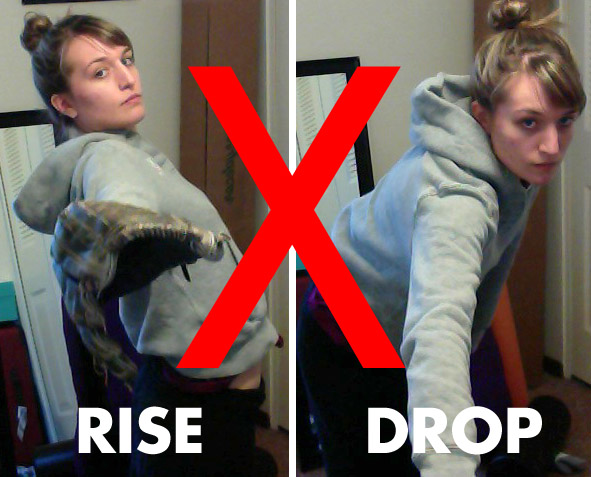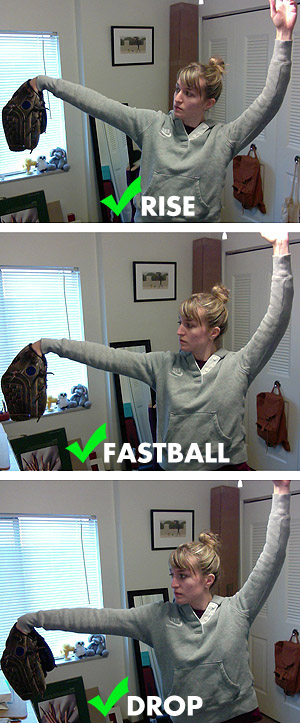I see a lot of extreme examples of changed body posture among windmill pitchers throwing drops and riseballs. It’s commonly taught to lean forward while throwing a drop and lean back while throwing a rise, but many of the pitchers who I see struggling with those pitches are leaning too much or in the wrong direction.
How much should your posture change during these pitches?
In my opinion, not a lot; you should stay pretty close to your fastball mechanics. You should be focusing on creating loose, quick arm action that results in tight spin to create most of your movement. On top of this, a slight change of your shoulder angle can help your pitches go where you want them to go. The keyword there is SLIGHT, and the angle change can be achieved by simply raising or lowering your glove by a few inches.
Where many pitchers go wrong
I see a lot of pitchers confuse a slight tilt of the shoulders for a major arching of the back or bending of the waist. Here’s what I mean:


The angle change is so slight that a lot of pitchers, especially those who are learning these pitches for the first time, can’t even feel it. Since they can’t feel it they end up exaggerating it so that they feel SOMETHING, and most often the exaggeration happens in the form of bending at the waist instead of keeping good posture and merely shifting back or forward slightly.
The incorrect exaggerated postures above are problematic because they put too much stress on the back, and they take your arm off the power line in one direction or the other so the pitch is also negatively affected.
With the drop in particular, I often see pitchers essentially throw a fastball and then follow through with a dramatic rounding of the shoulders after the ball has been released. This puts unnecessary stress on the back and does NOTHING for the pitch, since the ball has already left the pitcher’s hand by the time she attempts any drop action.
So here’s your drop/rise checklist:
- learn your spins well FIRST. That’s 90% of the pitch.
- make sure you’re in the right posture when your stride foot touches down, not after you’ve released the pitch.
- your back stays neutral and your glove steers; no bending or arching!
 Fastpitch Power Visor
1 × $18.00
Fastpitch Power Visor
1 × $18.00  Fastpitch Power+ Annual Subscription (STANDARD)
1 × $480.00 / year
Fastpitch Power+ Annual Subscription (STANDARD)
1 × $480.00 / year  Fastpitch Power+ Monthly Subscription (STANDARD)
1 × $48.00 / month
Fastpitch Power+ Monthly Subscription (STANDARD)
1 × $48.00 / month  Fastpitch Power+ Annual Subscription (PREMIUM)
1 × $720.00 / year
Fastpitch Power+ Annual Subscription (PREMIUM)
1 × $720.00 / year 

Good Morning Phil & Carly
I have a question regarding rise ball spins, specifically RPS (revolutions per second) with a riser. Recently a college camp we attended used a “spin counter” as pitchers were throwing fastballs/drops and told pitchers that they were wanting those 2 pitches to have a # between 20-22 RPS. So my question is; What is the optimal velocity and RPS for a “riser” to actually lift? (given it is spinning correctly)
I see most pitchers attempt to throw “risers” and what I see is a “bullet spin” high ball/fastball, I’ve even seen forward spin pitches that they will call a riser . Technically speaking, a “riser” should spin backwards if I’m not mistaken? I’m currently working with 1 of my advanced pitchers and her fastball/drop spins at 19-21 RPS @ 62mph but the “riser” is between 13-16 RPS. I’m thinking that RPS needs to increase to get lift. Do you have technical numbers regarding riser velocity and RPS? ( V+RPS = Lift )
Thanks for your expertise and keep up the good work
Fred Fitzpatrick
Tucson Az
Hi Fred, thanks for the question.
You are correct; the ideal spin for a rise ball is backwards. There is still a lot of debate about whether or not even this can get it to truly rise, but for sure a ball with forward spin or bullet spin is just going to be a high fastball.
I don’t have concrete RPS numbers for you, as this has not been effectively measured and studied in softball (to my knowledge). However, I don’t think you need concrete numbers to have a goal. If you think about the logical points:
• Tighter spin and more speed are always better, no matter what you’re throwing (change-ups aside of course)
• If the physics are still up for debate, at the very least you know it’s going to take A LOT of spin to make a ball rise… probably more than the average pitch.
Given that, I think aiming to have it spin at least as much as her other pitches is a good goal. This may not be possible, because the downward rotation of the wrist (as in the fastball and drop) is a more natural movement than the upward rotation (as in a rise ball). But you can set her normal RPS as a target, and rather than focusing solely on that, watch how the effectiveness of the pitch improves as she gets closer to it.
It all comes down to practical effectiveness. If batters are PERCEIVING lift and striking out, who cares what the ball is actually doing? The “jumping” fastball has been extensively studied in baseball, and the conclusion was that the lift is an illusion. The backward spin on the ball influences the surrounding air pressure just enough to make the ball fall slower/less than expected based on the speed and delivery angle. This makes the batter PERCEIVE lift. But in a game that’s all about keeping batters off balance, it works! Of course the softball delivery and ball are wildly different, but worst case scenario, even if it’s an illusion, it can be a good illusion.